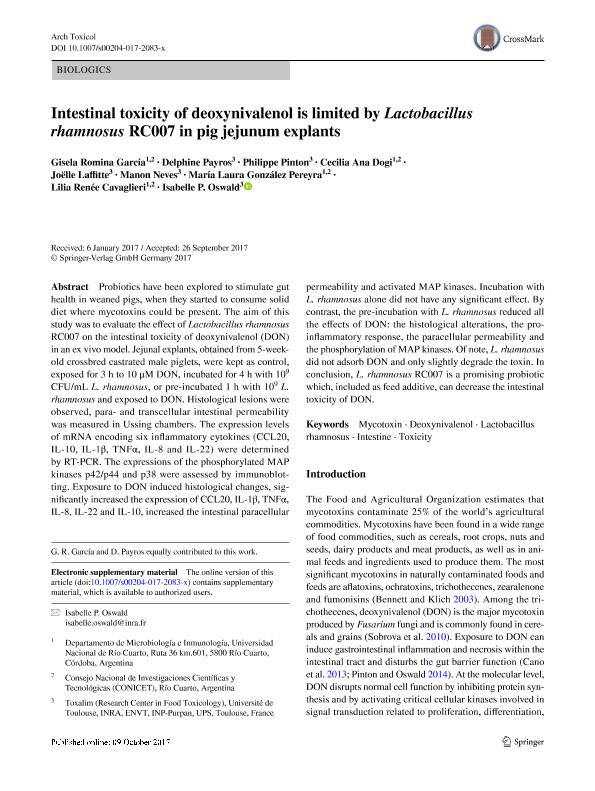Mostrar el registro sencillo del ítem
dc.contributor.author
García, Gisela Romina

dc.contributor.author
Payros, Delphine
dc.contributor.author
Pinton, Philippe
dc.contributor.author
Dogi, Cecilia Ana

dc.contributor.author
Laffitte, Joëlle
dc.contributor.author
Neves, Manon
dc.contributor.author
Gonzalez Pereyra, Maria Laura

dc.contributor.author
Cavaglieri, Lilia Reneé

dc.contributor.author
Oswald, Isabelle P.

dc.date.available
2021-06-02T18:34:35Z
dc.date.issued
2018-02
dc.identifier.citation
García, Gisela Romina; Payros, Delphine; Pinton, Philippe; Dogi, Cecilia Ana; Laffitte, Joëlle; et al.; Intestinal toxicity of deoxynivalenol is limited by Lactobacillus rhamnosus RC007 in pig jejunum explants; Springer; Archives of Toxicology; 92; 2; 2-2018; 983-993
dc.identifier.issn
0340-5761
dc.identifier.uri
http://hdl.handle.net/11336/133026
dc.description.abstract
Probiotics have been explored to stimulate gut health in weaned pigs, when they started to consume solid diet where mycotoxins could be present. The aim of this study was to evaluate the effect of Lactobacillus rhamnosus RC007 on the intestinal toxicity of deoxynivalenol (DON) in an ex vivo model. Jejunal explants, obtained from 5-week-old crossbred castrated male piglets, were kept as control, exposed for 3 h to 10 μM DON, incubated for 4 h with 109 CFU/mL L. rhamnosus, or pre-incubated 1 h with 109L. rhamnosus and exposed to DON. Histological lesions were observed, para- and transcellular intestinal permeability was measured in Ussing chambers. The expression levels of mRNA encoding six inflammatory cytokines (CCL20, IL-10, IL-1β, TNFα, IL-8 and IL-22) were determined by RT-PCR. The expressions of the phosphorylated MAP kinases p42/p44 and p38 were assessed by immunoblotting. Exposure to DON induced histological changes, significantly increased the expression of CCL20, IL-1β, TNFα, IL-8, IL-22 and IL-10, increased the intestinal paracellular permeability and activated MAP kinases. Incubation with L. rhamnosus alone did not have any significant effect. By contrast, the pre-incubation with L. rhamnosus reduced all the effects of DON: the histological alterations, the pro-inflammatory response, the paracellular permeability and the phosphorylation of MAP kinases. Of note, L. rhamnosus did not adsorb DON and only slightly degrade the toxin. In conclusion, L. rhamnosus RC007 is a promising probiotic which, included as feed additive, can decrease the intestinal toxicity of DON.
dc.format
application/pdf
dc.language.iso
eng
dc.publisher
Springer

dc.rights
info:eu-repo/semantics/openAccess
dc.rights.uri
https://creativecommons.org/licenses/by-nc-sa/2.5/ar/
dc.subject
DEOXYNIVALENOL
dc.subject
INTESTINE
dc.subject
LACTOBACILLUS RHAMNOSUS
dc.subject
MYCOTOXIN
dc.subject
TOXICITY
dc.subject.classification
Otras Ciencias Biológicas

dc.subject.classification
Ciencias Biológicas

dc.subject.classification
CIENCIAS NATURALES Y EXACTAS

dc.title
Intestinal toxicity of deoxynivalenol is limited by Lactobacillus rhamnosus RC007 in pig jejunum explants
dc.type
info:eu-repo/semantics/article
dc.type
info:ar-repo/semantics/artículo
dc.type
info:eu-repo/semantics/publishedVersion
dc.date.updated
2021-06-02T12:13:34Z
dc.journal.volume
92
dc.journal.number
2
dc.journal.pagination
983-993
dc.journal.pais
Alemania

dc.description.fil
Fil: García, Gisela Romina. Universidad Nacional de Río Cuarto. Facultad de Ciencias Exactas, Fisicoquímicas y Naturales. Departamento de Microbiología e Inmunología; Argentina. Consejo Nacional de Investigaciones Científicas y Técnicas. Centro Científico Tecnológico Conicet - Córdoba; Argentina
dc.description.fil
Fil: Payros, Delphine. Instituto National de Recherches Agronomiques. Centre de Recherches de Toulouse; Francia. Université Paul Sabatier; Francia
dc.description.fil
Fil: Pinton, Philippe. Instituto National de Recherches Agronomiques. Centre de Recherches de Toulouse; Francia. Université Paul Sabatier; Francia
dc.description.fil
Fil: Dogi, Cecilia Ana. Universidad Nacional de Río Cuarto. Facultad de Ciencias Exactas, Fisicoquímicas y Naturales. Departamento de Microbiología e Inmunología; Argentina. Consejo Nacional de Investigaciones Científicas y Técnicas. Centro Científico Tecnológico Conicet - Córdoba; Argentina
dc.description.fil
Fil: Laffitte, Joëlle. Instituto National de Recherches Agronomiques. Centre de Recherches de Toulouse; Francia. Université Paul Sabatier; Francia
dc.description.fil
Fil: Neves, Manon. Instituto National de Recherches Agronomiques. Centre de Recherches de Toulouse; Francia. Université Paul Sabatier; Francia
dc.description.fil
Fil: Gonzalez Pereyra, Maria Laura. Universidad Nacional de Río Cuarto. Facultad de Ciencias Exactas, Fisicoquímicas y Naturales. Departamento de Microbiología e Inmunología; Argentina. Consejo Nacional de Investigaciones Científicas y Técnicas. Centro Científico Tecnológico Conicet - Córdoba; Argentina
dc.description.fil
Fil: Cavaglieri, Lilia Reneé. Universidad Nacional de Río Cuarto. Facultad de Ciencias Exactas, Fisicoquímicas y Naturales. Departamento de Microbiología e Inmunología; Argentina. Consejo Nacional de Investigaciones Científicas y Técnicas. Centro Científico Tecnológico Conicet - Córdoba; Argentina
dc.description.fil
Fil: Oswald, Isabelle P.. Instituto National de Recherches Agronomiques. Centre de Recherches de Toulouse; Francia. Université Paul Sabatier; Francia
dc.journal.title
Archives of Toxicology

dc.relation.alternativeid
info:eu-repo/semantics/altIdentifier/url/https://link.springer.com/article/10.1007/s00204-017-2083-x
dc.relation.alternativeid
info:eu-repo/semantics/altIdentifier/doi/http://dx.doi.org/10.1007/s00204-017-2083-x
Archivos asociados
